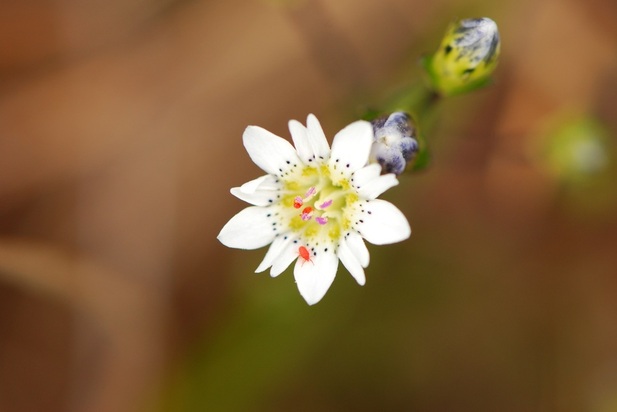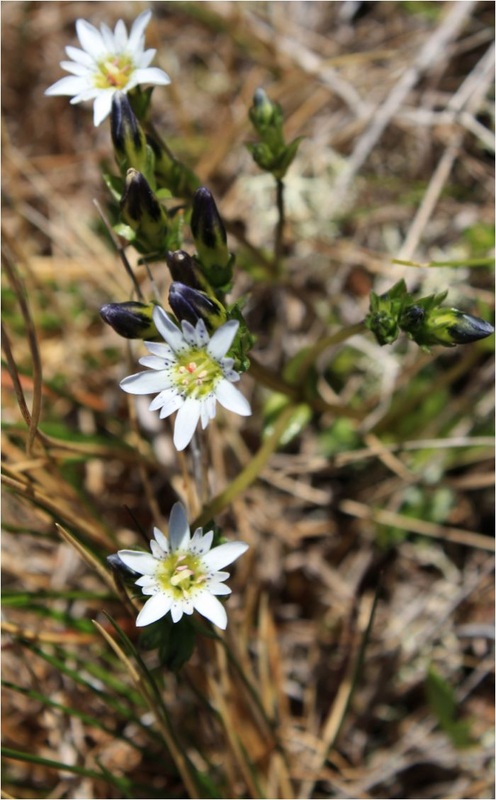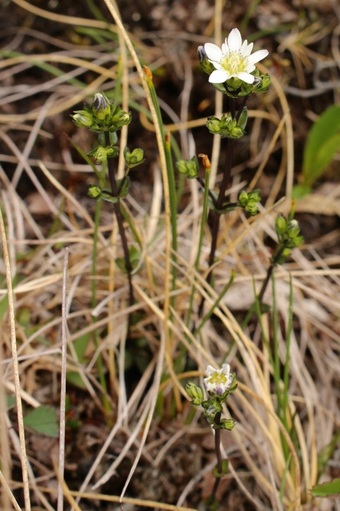Swamp gentian • Gentiana douglasiana
{douglasiana = after the explorer and botanist David Douglas}
Identification
Swamp gentian is an annual plant that grows 5-25 cm tall from a taproot. The stems grow upright and branch often. There are a few leaves at the base of the plant (basal leaves); they are small (to 1.5 cm long), are egg-shaped or elliptical, and form a rosette around the base. The stem leaves are similar in size and shape, and are also not numerous. This species is easy to identify when in bloom: the distinctive flowers are white with small purple spots and streaks; the undersides of open flowers (and therefore flower buds) are purplish-blue. The flowers are tubular (no separate petals): what look like petals are actually five large lobes separated by smaller lobes. The relatively small (to 1.5 cm long) flowers appear singly or in clusters at the top of a stem.
Habitat & Range
Swamp gentian, as the name suggests, grows in wet areas like bogs, fens, and wet meadows. It will not grow in shady areas, and prefers nitrogen-poor soils. It is found in low and subalpine elevations along the BC coast. Its range stretches north into southeastern Alaska, and south into Washington.
Similar Species
Northern gentian is a similar species with purple flowers, and is not a common species on the coast; it is generally found east of the Cascade Mountains.
iNaturalist
https://www.inaturalist.org/taxa/163228-Gentiana-douglasiana
Swamp gentian is an annual plant that grows 5-25 cm tall from a taproot. The stems grow upright and branch often. There are a few leaves at the base of the plant (basal leaves); they are small (to 1.5 cm long), are egg-shaped or elliptical, and form a rosette around the base. The stem leaves are similar in size and shape, and are also not numerous. This species is easy to identify when in bloom: the distinctive flowers are white with small purple spots and streaks; the undersides of open flowers (and therefore flower buds) are purplish-blue. The flowers are tubular (no separate petals): what look like petals are actually five large lobes separated by smaller lobes. The relatively small (to 1.5 cm long) flowers appear singly or in clusters at the top of a stem.
Habitat & Range
Swamp gentian, as the name suggests, grows in wet areas like bogs, fens, and wet meadows. It will not grow in shady areas, and prefers nitrogen-poor soils. It is found in low and subalpine elevations along the BC coast. Its range stretches north into southeastern Alaska, and south into Washington.
Similar Species
Northern gentian is a similar species with purple flowers, and is not a common species on the coast; it is generally found east of the Cascade Mountains.
iNaturalist
https://www.inaturalist.org/taxa/163228-Gentiana-douglasiana
References
Gentiana douglasiana Bong. In Klinkenberg, Brian. (Ed.). E-Flora BC: Electronic Atlas of the Plants of British Columbia. Lab for Advanced Spatial Analysis, Department of Geography, University of British Columbia, Vancouver. Accessed 14/08/2013.
Pojar, J. and MacKinnon, A. (1994). Plants of Coastal British Columbia. Vancouver, BC: Lone Pine Publishing. P. 229.
Authors and editors of page
Kelly Fretwell and Brian Starzomski (2013).
Gentiana douglasiana Bong. In Klinkenberg, Brian. (Ed.). E-Flora BC: Electronic Atlas of the Plants of British Columbia. Lab for Advanced Spatial Analysis, Department of Geography, University of British Columbia, Vancouver. Accessed 14/08/2013.
Pojar, J. and MacKinnon, A. (1994). Plants of Coastal British Columbia. Vancouver, BC: Lone Pine Publishing. P. 229.
Authors and editors of page
Kelly Fretwell and Brian Starzomski (2013).







